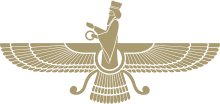
Back فارافاهار Arabic Фаравахар Byelorussian Фаравахар Bulgarian ফারাওয়াহার Bengali/Bangla Faravahar Catalan فرەوەھر CKB Faravahar Czech Faravahar German Fırwehar DIQ Φραβαχάρι Greek


| Part of a series on |
| Zoroastrianism |
|---|
 |
|
|
The Farvahar (Persian: فَرْوَهَر), also known as the Foruhar (فروهر) or the Farre Kiyâni[1] (فر کیانی), is one of the best-known symbols of Zoroastrianism, an Iranian religion. There are various interpretations of what the Faravahar symbolizes, and there is no concrete universal consensus on its meaning. However, it is commonly believed that the Faravahar serves as a Zoroastrian depiction of the fravashi, or personal spirit.[2][3]
The Faravahar is one of the best-known and most used pre-Islamic symbols of Iran and is often worn as a pendant. Despite its traditionally religious nature, it has become a secular and cultural symbol for Iranians.[4][5][6]
- ^ book_rahnamaye_TakhteJamshid. Author: Shahpoor Shahbazi
- ^ Boyce 2000, pp. 195–199.
- ^ "FRAVAŠI – Encyclopaedia Iranica". www.iranicaonline.org. Retrieved 4 April 2020.
- ^ "Europe | The Identity Necklace: Being Iranian in Britain". FRONTLINE - Tehran Bureau. Retrieved 4 April 2020.
- ^ staff, T. O. I.; Agencies. "Iran official: If US attacks, Israel will be destroyed in half an hour". www.timesofisrael.com. Retrieved 4 April 2020.
- ^ Szanto, Edith (15 May 2018). ""Zoroaster was a Kurd!": Neo-Zoroastrianism among the Iraqi Kurds". Iran and the Caucasus. 22 (1): 96–110. doi:10.1163/1573384X-20180108. ISSN 1573-384X.
© MMXXIII Rich X Search. We shall prevail. All rights reserved. Rich X Search